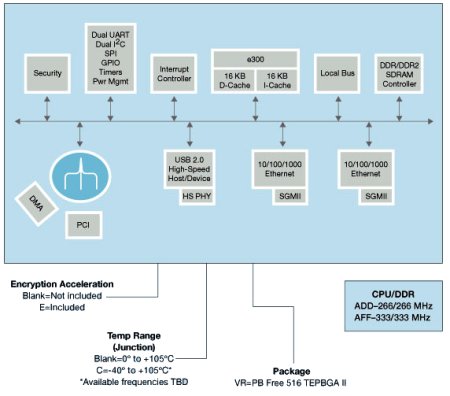Low-cost NPU offers dual gigE, HSE, Linux support
Nov 15, 2006 — by LinuxDevices Staff — from the LinuxDevices Archive — 11 viewsFreescale is sampling an inexpensive PowerQUICC II network processor (NPU) with integrated hardware security engine (HSE), dual gigabit Ethernet interfaces, and USB 2.0. The MPC8313E targets residential gateways, 802.11n access points, piracy-protected media servers, line cards, intelligent NICs, and network storage devices, and an ultra-low power derivative will support printers.
The MPC8313E was designed entirely at Freescale's India Design Center, in Noida, India, Freescale says. The product debuted at Freescale's Technology Forum there, today.
The “E” suffix indicates inclusion of an HSE, in this case with hardware acceleration for the DES, 3DES, AES, SHA-1, and MD-5. The HSE makes the MPC8313E suitable for media equipment requiring security (“piracy prevention”), according to the company.
QoS (quality of service) is also supported, suiting the chip for use in devices compliant with DLNA (Digital Living Network Alliance) standards for easy media management, viewing, printing, and sharing, according to Freescale.
Additionally, an “SC8311” derivative of the MPC8313 will be available specially for the laser printer market. It will implement advanced low-power capabilities aimed at helping vendors meet emerging power regulations in European and Japanese markets, Freescale says.
The MPC8313E's e300 PowerPC core is said to deliver 700 MIPS (millions of instructions per second) at its max clock of 333MHz. The core has 16KB each of L1 data and instruction cache, and MMU (memory management unit).

MPC8313E function block diagram
(Click to enlarge)
The MPC8313E integrates a 32-bit DDR-1/2 memory controller, also clockable to 333MHz. There's a 16-bit local bus for interchip connections, four DMA channels, and quite a few high-speed on-chip peripheral interfaces, including a pair of gigabit Ethernet interfaces and USB 2.0 with Phy integration. The device also includes a 32-bit PCI controller for 3.3V peripherals.
Freescale says the MPC8313E includes power management hardware, and supports ACPI, a technology more often associated with x86. The chip draws only 300mW when standing by, the company claims.
Additional touted features include:
- Supports the IEEE 1588 timing protocol, for industrial control and test and measurement applications
- Gigabit Ethernet SGMII serial interface, for LAN control and switching applications
- 90nm process technology enables 1.0V core voltage and 3.3V I/O.
- 516-pin PBGA package
The MPC8313E is compatible with PowerQUICC II devices and legacy PowerQUICC chips, Freescale says, fostering code reuse, key peripheral integration, reference design availability, and development tools and support availability. PowerQUICC II chips have traditionally been well-supported in Linux-based embedded designs, by embedded Linux vendors such as TimeSys, Wind River, and Freescale's internal software tools team (formerly Metrowerks); microcode providers such as Arabella and DoGav; and stack/reference design vendors such as Trinity Convergence, Axentra, and Freescale itself, among others.
Availability
Initial MPC8313E samples are available now, with general sample availability in Q1 of 2007. Genebal availability is set for Q2 of 2007, priced at $15 in quantities of 10K.
This article was originally published on LinuxDevices.com and has been donated to the open source community by QuinStreet Inc. Please visit LinuxToday.com for up-to-date news and articles about Linux and open source.